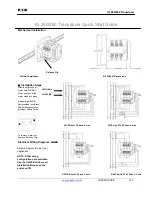
9.
DESCRIPTION OF HART INTERFACE
9.1 General description
The HART
®
Protocol is an open digital communication protocol for industry. It is free to use by
anyone. It is included in the software embedded in signal converters of HART-compatible
devices.
There are 2 classes of devices which support the HART
®
Protocol: operating devices and field
devices. There are 2 classes of operating devices (Master): PC-supported workstations (Primary
Master) and manual control units (Secondary Master). These can be used in control centres and
other locations. HART
®
field devices include sensors, converters and actuators. Field devices
include 2-wire and 4-wire devices, and also intrinsically-safe versions for use in hazardous
areas.
There are 2 primary operation modes for HART-compatible devices: point-to-point mode and
multi-drop mode.
If the device is used in point-to-point mode, the HART
®
Protocol uses the Bell 202 Frequency
Shift Keying (FSK) standard to put a digital signal on top of the 4...20 mA signal. The connected
device sends and receives digital signals that agree with the HART
®
Protocol, and sends analog
signals at the same time. Only 1 device can be connected to the signal cable.
If the device is used in multi-drop mode, the network only uses a digital signal that agrees with
the HART
®
Protocol. The loop current is set to 4 mA. You can connect a maximum of 15 devices
to the signal cable.
An FSK or HART
®
modem is included in field devices and manual control units. It is necessary to
have an external modem for PC-supported workstations. The external modem is connected to
the serial interface.
9.2 Software history
INFORMATION!
In the table below, "x" is a placeholder for possible multi-digit alphanumeric combinations,
depending on the available version.
Release date
Devices
HART
®
Device Revision
DD Revision
2008-03
All revisions
1
2
Te
gy Solutions
chnolo
Instruction Manual
Tek-Flex
4100A
www.tek-trol.com
1
33
















































